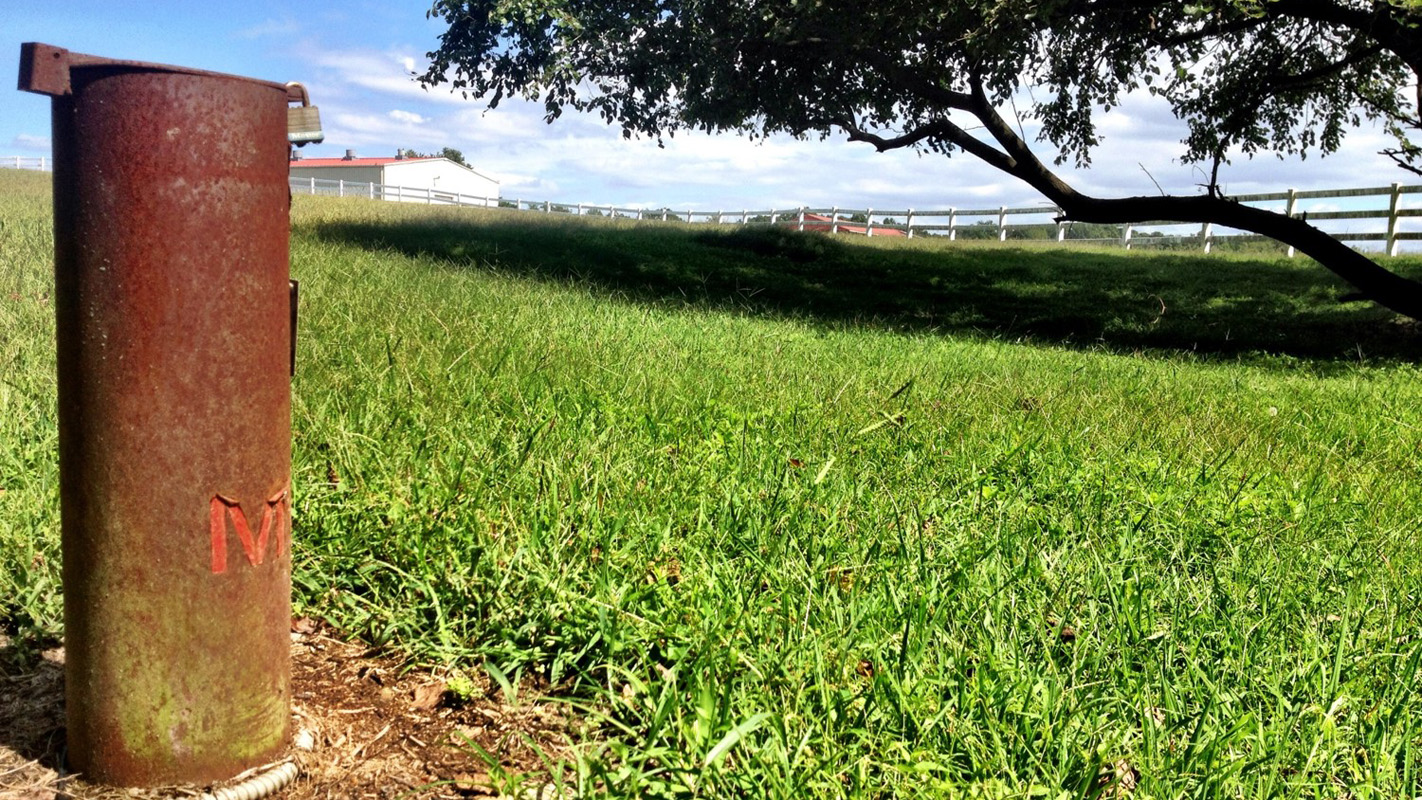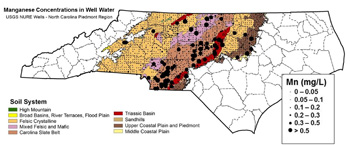Study Reveals Soil Influence on Well Water Manganese Levels

NC State researchers examine troves of data to find out why more than 1 million southeastern Piedmont residents have high levels of manganese in their well water.
Utilizing a wide range of analytic tools, researchers at North Carolina State University have figured out why pockets of the southeastern Piedmont region contain high concentrations of manganese in well water, particularly in more shallow wells. The findings highlight the importance of testing well water to ensure its safety.
More than 1 million southeastern Piedmont residents in four states – North and South Carolina, Virginia and Georgia – use well water that has manganese levels above recognized water-quality standards, according to the study; recent health studies show associations between high well-water manganese levels and heart defects, developmental defects and cancer. Manganese in water can also stain clothes and household appliances, like dishwashers.
“We wanted to characterize the distribution of this naturally occurring element in both solid and water materials in the southeastern Piedmont, and we wanted to measure these concentrations from the soil surface all the way to the bedrock,” said Matt Polizzotto, associate professor of crop and soil sciences and corresponding author of a paper describing the work in Environmental Science & Technology.
“We found that more shallow wells were more likely to have high concentrations of manganese,” Polizzotto added.
“The Piedmont’s geology and hydrology play a huge role in how manganese spreads,” said NC State Ph.D. student Elizabeth Gillispie, lead author of the paper. “When bedrock weathers, or breaks down to form soil, you get a buildup of manganese in the saprolite, the layer just below the soil surface and near the water table. That’s why some of the shallow wells have higher concentrations of manganese.”
Yet the porousness of the North Carolina saprolite, where a great deal of groundwater is stored, helps move manganese deeper into the bedrock.
“When the saprolite is exposed to water, manganese can be released into the water and migrate down to bedrock aquifers,” Gillispie said. “The fractured nature of the bedrock makes it difficult to track where weathered materials end up, because these fractures can take these materials far away from their points of origin.”

The researchers analyzed a wide range of samples and assembled troves of data – from groundwater monitoring stations across North Carolina that paint a picture of the state’s hydrology to databases of manganese concentrations in wells across the Piedmont – to capture the movement of manganese in soil and water in the Piedmont.
“We ultimately attempted to create an integrated model to really understand what’s happening in well water from the surface to the bedrock, which means including geologists and hydrologists, along with soil scientists, to expand our knowledge,” Polizzotto said.
The researchers suggest getting well water tested – especially water coming from more shallow wells – and then suggest using filters to mitigate high levels of any metals, including manganese. They also suggest burying new wells deeper into the ground, although they realize that process can be more expensive than building shallow wells.
The research was supported by the University of North Carolina’s Water Resources Research Institute. Researchers from the N.C. Division of Water Resources and the N.C. Geological Survey co-authored the paper.
– kulikowski –
Note to editors: An abstract of the paper follows.
“Soil Weathering as an Engine for Manganese Contamination of Well Water”
Authors: Elizabeth C. Gillispie, Robert E. Austin, Nelson A. Rivera, Owen W. Duckworth, Aziz Amoozegar, Dean Hesterberg and Matthew L. Polizzotto, North Carolina State University; Rick Bolich, N.C. Division of Environment and Natural Resources; Phil Bradley, N.C. Geological Survey
Published: Online Aug. 29, 2016, in Environmental Science & Technology
DOI: 10.1021/acs.est.6b01686
Abstract: Manganese (Mn) contamination of well water is recognized as an environmental health concern. In the southeastern Piedmont region of the United States, well-water Mn concentrations can be >2 orders of magnitude above health limits, but the specific sources and causes of elevated Mn in groundwater are generally unknown. Here, using field, laboratory, spectroscopic, and geospatial analyses, we propose that natural pedogenetic and hydrogeochemical processes couple to export Mn from the near-surface to fractured-bedrock aquifers within the Piedmont. Dissolved Mn concentrations are greatest just below the water table and decrease with depth. Solid-phase concentration, chemical extraction, and X-ray absorption spectroscopy data show that secondary Mn oxides accumulate near the water table within the chemically weathering saprolite, whereas less-reactive, primary Mn-bearing minerals dominate Mn speciation within the physically weathered transition zone and bedrock. Mass-balance calculations indicate soil weathering has depleted over 40% of the original solid-phase Mn from the near-surface, and hydrologic gradients provide a driving force for downward delivery of Mn. Overall, we estimate that >1 million people in the southeastern Piedmont consume well water containing Mn at concentrations exceeding recommended standards, and collectively, these results suggest that integrated soil-bedrock-system analyses are needed to predict and manage Mn in drinking-water wells.
This post was originally published in NC State News.


